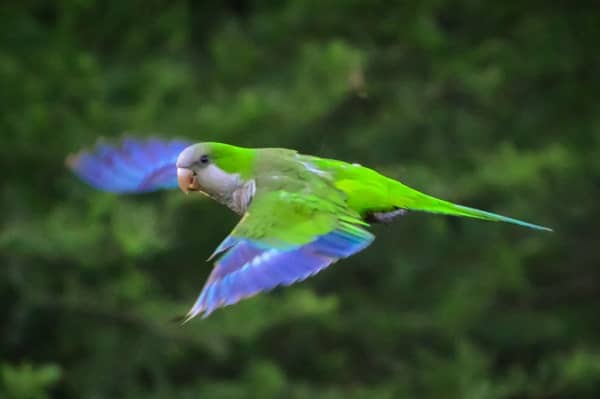All About the Monk Parakeet
The monk parakeet is usually about 11 or 12 inches long, and they have long tails. With predominantly green coloring above the face, along the back, on the belly, and in the tail features, monk parakeets live in large colonies. Monk parakeets live in their nests throughout the entire year, and they usually lay eggs between April and July with a possible second clutch in early fall. Monk parakeets live in busy cities and in quieter neighborhoods throughout the country.

Habitat
Monk parakeets living in North America might live in both urban and suburban habitats. They tend to live around city parks. These parrots are unusual, because they are able to live in areas where it gets cold during the winter. The native range for monk parakeets is in the dry savannas and woodlands of South America. Elevation in these areas reaches up to approximately 6,000 feet.
- The Natural Habitat of Parakeets – Different types of parakeets have different habitats, but they are all social birds.
- Monk Parakeet – As the only nest-building parrot, monk parakeets have been able to spread further to adapt to colder climates.
Food
Monk parakeets eat a variety of foods. Their diet consists of berries, blossoms, buds, fruits, nuts, and seeds. They will also eat some types of crops, including corn, rice, sorghum, sunflower, and wheat. The addition of crops to the monk parakeet diet has caused the bird to develop a reputation as a pest, although confirmation of this has not been finalized. During the winter, monk parakeets may visit backyard bird feeders to supplement their daily diet.
- Monk Parakeet – Monk parakeets are also called quaker parakeets.
- Quaker Parrot Feeding Guide – Monk parakeets like fresh fruits and berries, such as blackberries and figs.
Nesting
Monk parakeets build nests in palm trees, deciduous trees, and evergreen trees. They will also nest in structures and on utility poles. These birds are the only type of parrot that will build stick nests and that nest colonially, which means that they nest in groups with other monk parakeets. The bulky nests they build are ideal as year-round homes, and this may be a contributing factor for the birds surviving during cold winter weather. An average nest structure usually has up to 20 chambers, and a large structure could have more than 200 chambers. All of the birds in a colony help build and maintain nests. Pairs of birds build onto the structure by creating a floor first, then adding sides and a roof to enclose the chamber. A tunnel serves as an entrance, and the chamber even has a wider area at the nest opening with enough room for birds to pass each other or turn around. A full nest structure might be more than five feet wide, and it could weigh a ton. The birds have also been known to use thorny twigs to build their nests, which may help protect from predators.
- Nesting Behavior of Monk Parakeets – When monk parakeets build nests on utility poles, they can cause fires and power outages.
- Monk Parakeet Overview – Monk parakeets are the only species that makes nests out of plant materials.
Behavior
These birds exhibit social behavior, living their entire lives in busy colonies. In the morning, the birds leave their nests to forage. They climb through trees or scour the ground to find food. At dusk, the birds congregate again at the nest to roost. Monk parakeets are also known for their preening behavior. They pair off into monogamous units, courting by preening each other and grasping each other’s beaks while shaking their heads.
- About Quaker Parakeet – Quaker or monk parakeets can be tamed, and they often develop a bond with a human owner.
- Quaker / Monk Parrot – Some people call monk parakeets Quaker parrots because their facial feathers look like a Quaker costume.
Conservation
Pet monk parakeets were released or escaped during the 1960s in the United States. Since that time, the birds have been increasing in numbers throughout the country. The parrots can be found in many states but are most prevalent in Florida, California, and Texas. In Austin, Texas for example the East Austin neighborhood is known for having a large number of these vibrant parrots. Monk parakeets are also prevalent in South America. In the past, monk parakeet management efforts in the United States and South America have focused on curbing bird populations because of their reputation as a pest. Because the bird population has persisted but not spread, controlling their numbers is no longer a goal. Partners in Flight estimates the global breeding population of monk parakeets at 20 million birds, and three percent of this population is in the United States. Monk parakeets’ Continental Concern Score is at six out of 20.
- Beyond Conservation Concern: Monk Parakeets Hold Clues About Human Influences on Evolutionary Processes – Research is being conducted to learn how monk parakeets have colonized so successfully outside of their native environment.
- Monk Parakeet Conservation
- Focal Species: Monk Parakeet (PDF) – Monk parakeets have spread throughout about 20 states, and they may be indirectly harming native species because of their diet of fruit.
3,057 total views, 1 views today
